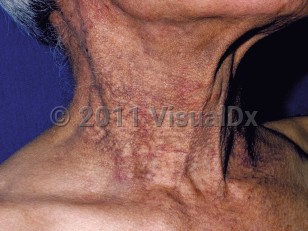While some aspects of the etiology remain unclear, investigations, particularly in Japan, have found that the hyperpigmentation stems from sensitivity to certain chemicals in cosmetics. In these investigations, hundreds of patients were shown to have positive patch tests to cosmetics and their ingredients, and their hyperpigmentation significantly improved after avoiding cosmetics with those allergens.
Common chemicals implicated in pigmented contact dermatitis include:
- Fragrances – hydroxycitronellal, benzyl salicylate, jasmine absolute, ylang-ylang oil, cananga oil, sandalwood oil, eugenol, cinnamic derivatives, hydroperoxides of limonene, and balsam of Peru
- Pigments – D & C Red 31, Red 225; D & C Yellow 11, Yellow 10; and pigments containing phenyl-azo-e-naphthol, aniline dyes, kumkum (a red powder commonly used by Hindu women), and henna
- Optical whiteners
- Coal tar derivatives, which increase photosensitivity
- Bactericidals – carbanilides such as trichlocarban and halocarban



